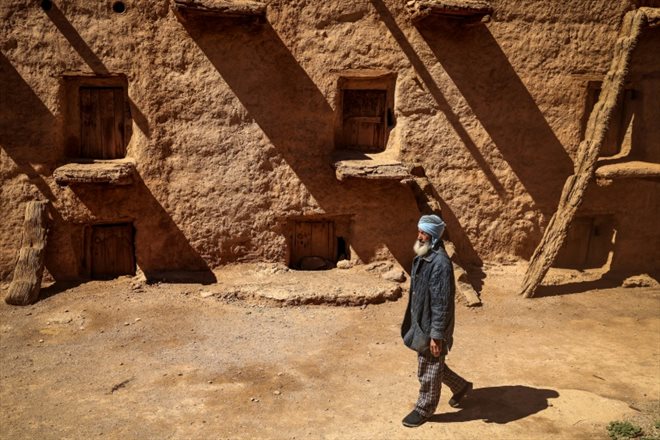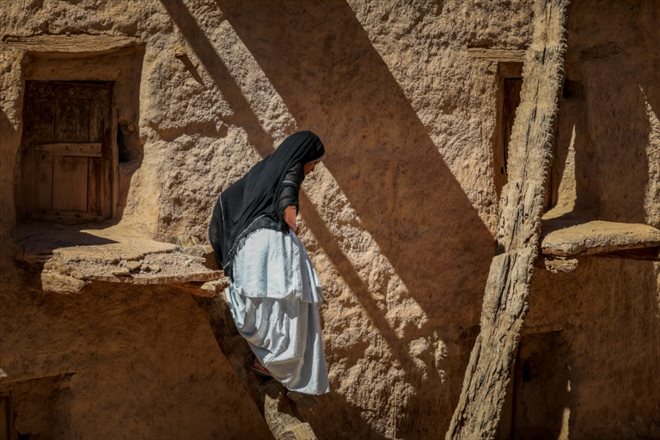Lahcen Boutirane, caretaker of an old granary, walks on the battlements of the village of Aït Kine, in Morocco, on March 1, 2023 (AFP/FADEL SENNA)
“Traditions are disappearing but not with us,” murmurs Hossine Oubrahim, a dean of the village of Aït Kine, which is home to one of the few collective granaries still in operation in southern Morocco.
About fifty kilometers from the town of Tata, this Berber village of the Anti-Atlas is perched at more than 1,000 meters above sea level.
In a landscape of olive and palm trees, backed by stratified hills, the town is a window on the heritage heritage of the kingdom.
Imposing citadel for the protection and storage of village property, its collective attic (called “agadir” in the Amazigh language), probably built in the 18th century and restored in 2012, is still functional, witness to a centuries-old community organization that is tending to disappear. .
“We grew up with the tradition of storing our seeds, dried fruits, oils and valuables there,” Oubrahim told AFP.
“And we continue to respect it”, proudly asserts the septuagenarian draped in the traditional indigo blue tunic of the Berbers.
Pride. The word often comes up in the mouths of the inhabitants of Aït Kine when referring to the “monument” which “represents our community spirit”, adds Abdelghani Charai, a 60-year-old trader returning to the land of his ancestors after years of wanderings.
– Protection and security –

Lahcen Boutirane, caretaker of an old granary, walks in his enclosure, in the village of Aït Kine, in Morocco, on March 1, 2023 (AFP/FADEL SENNA)
The agadir, built in adobe in the center of the village, is protected by an almost impassable wall, surmounted by a stone watchtower.
Inside, 76 compartments are arranged in three levels around an open courtyard where a stone cistern has been placed for the storage of water.
“There are 63 families left in the village who each use their hut. The others have left but they keep their archives here”, confides the caretaker, Lahcen Boutirane.
They store barley, dates, almonds, but also documents, such as marriage and birth certificates, religious texts and contracts, recipes for magic remedies, written on palm stems.
“The granary was a guarantee of security, especially in the event of + siba +”, of rebellion of the local tribes against the central power, explains Mr. Charai.
Collective granaries are considered sacred and inviolable spaces, governed by customary rights, protecting crops in the event of drought but also attacks, confirms archaeologist Naïma Keddane, specialist in these Anti-Atlas buildings, a mountain range in southwestern Morocco.
“By all the history it contains, it is important to keep a link with this place which testifies to the ingenuity of our ancestors”, pleads Lahcen Boutirane, who has watched over the attic of Aït Kine for years.
– “Solidarity institutions” –

A woman sits in an old attic in the village of Aït Kine, Morocco, on March 1, 2023 (AFP/FADEL SENNA)
If there are still collective granaries in North Africa, in Algeria in the Aurès, in southern Tunisia and in Libya in the Djebel Nefoussa, it is in Morocco that they are most numerous, even if most are not more used.
The kingdom has more than 550 former “iguidar” (the plural of agadir) in different regions, mainly in the Center and the South, according to the Ministry of Culture which is preparing their inscription on the UNESCO World Heritage List.
The variety of these constructions attests to their heritage value: attics in caves or on the side of cliffs, crowning hills or dominating a valley.
“The challenge is to save Moroccan collective granaries when they have almost disappeared in Algeria, Tunisia and Libya,” says architect and anthropologist Salima Naji.
Passionate about these “solidarity institutions”, she undertook the restoration of the Agadir of Aït Kine, which now attracts both scholars and simply curious people.

A woman sits in an old attic in the village of Aït Kine, Morocco, on March 1, 2023 (AFP/FADEL SENNA)
Emanuele Maspoli, a tour operator, today accompanies Italian tourists who machine-gun the beautiful carved wooden door, adorned with wrought iron, of the attic.
“We go around the granaries of the region, extraordinary places that bear witness to the historical richness of Moroccan oases”, boasts the fifty-year-old guide who has been traveling Morocco for ten years.
“It’s a magical place!” enthuses Antonella Dalla, one of the tourists, as she walks up and down the attic.
© 2023 AFP
Did you like this article ? Share it with your friends with the buttons below.




